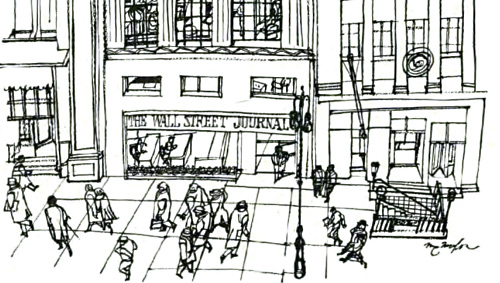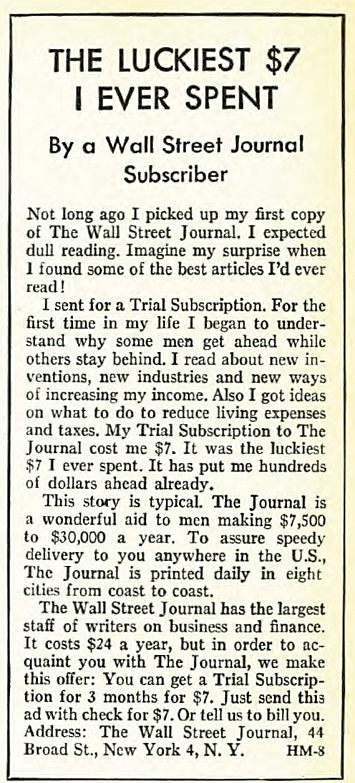“Exclusive: Rupert Murdoch Speaks,” Time, July 28, 2007:
The owner-in-waiting will eventually want to see some [changes], starting on Page One. He has little taste for the quirky “A-head” stories that run in the center columns. “To have these esoteric, well-written stories on Page One every day is great,” he says, in a tone of voice that implies it’s not so great. “But I still think you want some hard news. I’d try to keep many more of them for the weekend. I’m sick of putting the Journal aside because I don’t have time to get through these stories.”

John Brooks, “The Wall Street Journal Woos the Eggheads,” March 1959:
A Journal leader is really a small magazine article rather than a news story. It may run to magazine-article length–two thousand words or more–and it always tries to attain magazine-article depth and thoroughness. Its subject is usually something of fairly crucial interest to businessmen, but at times, it may take up matters primarily for their intrinsic interest. For example, last summer the Journal ran a leader that presented the most complete and lucid account printed anywhere of Louis Wolfson’s complicated dealings in American Motors stock. In the course of one week last fall, there were leaders on new wrinkles in frozen-food packaging; a pick-up in automobile sales; the promising new drugs for heart disease; the United Auto Workers’ election-campaign tactics; the situation in commercial production of atomic power plants; the status of the Gomulka government in Poland; the appalling railroad-car shortage that would develop in case of war; the financial plight of opera companies; and the decline of the hula-hoop fad, Packed with information that had been closely checked and intelligently collated, such articles, while of bread-and-butter interest to a few readers, have a special appeal for amateur sociologists, trend-spotters, people in search of topics for cocktail conversation, and those who take an innocent delight in knowing what’s going on around them.
“The Luckiest $7 I Ever Spent” (Advertisement), July 1963:

Harper’s Index, June 2002:
Number of artists employed full-time by the Wall Street Journal to convert photographs into faux engravings : 5


